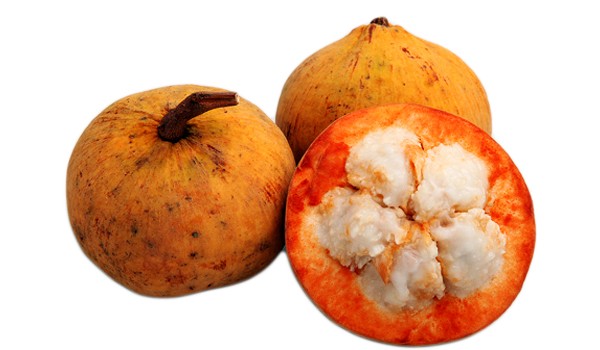- Overview
Santol Tree in a 3 Gallon Container. Santol is a common fruit in the markets throughout Indonesia and the Philippines. The fruit is about the size of a baseball and it has a thin rind. The pulp is sweet to sub-acid and surrounds several large seeds. The fruit are typically eaten fresh, but they are also used to make jellies and preserves throughout India and Malaysia.
Description
Origin and Distribution
Varieties
Climate
Soil
Propagation
Season
Pests
Food Uses
Other Uses
Medicinal UsesPerhaps the only important edible fruit in the family Meliaceae, the santol, Sandoricum koetjape Merr. (syns. S. indicum Cav., S. nervosum Blume, Melia koetjape Burm. f.), is also known as sentieh, sentol, setol, sentul, setul, setui, kechapi or ketapi, in Malaya; saton, satawn, katon, or ka-thon in Thailand; kompem reach in Cambodia; tong in Laos; sau chua, sau tia, sau do, mangoustanier sauvage, or faux mangoustanier in North Vietnam. In the Philippines, it is santor or katul; in Indonesia, ketjapi or sentool; on Sarawak and Brunei, it is klampu. In India, it may be called sayai, sevai, sevamanu or visayan. In Guam, it is santor or wild mangosteen.
Description
The santol is a fast-growing, straight-trunked, pale-barked tree 50 to 150 ft (15-45 m) tall, branched close to the ground and buttressed when old. Young branchlets are densely brown-hairy. The evergreen, or very briefly deciduous, spirally-arranged leaves are compound, with 3 leaflets, elliptic to oblong-ovate, 4 to 10 in (20-25 cm) long, blunt at the base and pointed at the apex. The greenish, yellowish, or pinkish-yellow, 5-petalled flowers, about 3/8 in (1 cm) long are borne on the young branchlets in loose, stalked panicles 6 to 12 in (15-30 cm) in length. The fruit (technically a capsule) is globose or oblate, with wrinkles extending a short distance from the base; 1 1/2 to 3 in (4-7.5 cm) wide; yellowish to golden, sometimes blushed with pink. The downy rind may be thin or thick and contains a thin, milky juice. It is edible, as is the white, translucent, juicy pulp (aril), sweet, subacid or sour, surrounding the 3 to 5 brown, inedible seeds which are up to 3/4 in (2 cm) long, tightly clinging or sometimes free from the pulp.
Origin and Distribution
The santol is believed native to former Indochina (especially Cambodia and southern Laos) and Malaya, and to have been long ago introduced into India, the Andaman Islands, Malaysia, Indonesia, the Moluccas, Mauritius, and the Philippines where it has become naturalized. It is commonly cultivated throughout these regions and the fruits are abundant in the local markets.
Only a few specimens are known in the western hemisphere: one in the Lancetilla Experimental Garden at Tela, Honduras, and one or more in Costa Rica. Seeds have been introduced into Florida several times since 1931. Most of the seedlings have succumbed to cold injury. At least 3 have survived to bearing age in special collections. Grafted plants from the Philippines have fruited well at Fairchild Tropical Garden, Miami.
In Asia and Malaysia, the tree is valued not just for its fruit, but for its timber and as a shade tree for roadsides, being wind-resistant and non-littering.
Varieties
There are two general types of santol: the Yellow (formerly S. indicum or S. nervosum); and the Red (formerly S. koetjape). The leaflets of the Yellow, to 6 in (15 cm) long, turn yellow when old; the flowers are pinkish-yellow in panicles to 6 in (15 cm) long; the fruit has a thin rind and the pulp is 1/4 to 1/2 in (0.6-1.25 cm) thick around the seeds and typically sweet. The fruit may not fan when ripe. Only the Yellow is now found wild in Malayan forests.
The leaflets of the Red, to 12 in (30 cm) long, velvety beneath, turn red when old; the flowers are greenish or ivory, in panicles to 12 in (30 cm) long; the fruit has a thick rind, frequently to 1/2 in (1.25 cm); there is less pulp around the seeds, and it is sour. The fruit falls when ripe.
However, Corner says that these distinctions are not always clear-cut except as to the dying leaf color, and the fruit may not correspond to the classifications. There are sweet and acid strains of both the Yellow and Red types and much variation in rind thickness.
Climate
The santol is tropical and cannot be grown above 3,280 ft (1,000 m) in Java. It flourishes in dry as well as moist areas of the Philippine lowlands.
Soil
The tree has grown well in Florida in acid sandy soil and oolitic limestone, but in the latter the foliage becomes chlorotic.
Propagation
The santol is reproduced by seeds, air-layering, inarching, or by budding onto self rootstocks.
Season
The fruit ripens in Malaya in June and July; in Florida, August and September; in the Philippines, from July to October.
Pests
The Caribbean fruit fly (Anastrepha suspensa) causes freckle-like blemishes on the surface of the fruit but cannot penetrate the rind.
Food Uses
The fruit is usually consumed raw without peeling. In India, it is eaten with spices. With the seeds removed, it is made into jam or jelly. Pared and quartered, it is cooked in sirup and preserved in jars. Young fruits are candied in Malaysia by paring, removing the seeds, boiling in water, then boiling a second time with sugar. In the Philippines, santols are peeled chemically by dipping in hot water for 2 minutes or more, then into a lye solution at 200º F (93.33º C) for 3 to 5 minutes. Subsequent washing in cool water removes the outer skin. Then the fruits are cut open, seeded and commercially preserved in sirup. Santol marmalade in glass jars is exported from the Philippines to Oriental food dealers in the United States and probably elsewhere. Very ripe fruits are naturally vinous and are fermented with rice to make an alcoholic drink.
Food Value Per 100 g of Edible PulpYellow*
Red**
Fruits (unspecifiedtype)***
Moisture
87.0 g
83.07-85.50 %
85.4 g
Protein
0.118 g
0.89 %
0.06 g
Carbohydrates
11.43 %
Fat
0.10 g
1.43 %
0.52 g
Fiber
0.1 g
2.30 %
1.26 g
Ash
0.31 g
0.65-0.88 %
0.39 g
Calcium
4.3 mg
0.01 %
5.38 mg
Phosphorus
17.4 mg
0.03 %
12.57 mg
Iron
0.42 mg
0.002 %
0.86 mg
Carotene
0.003 mg
Thiamine
0.045 mg
0.037 mg
Niacin
0.741 mg
0.016 mg
Ascorbic Acid
86.0 mg
0.78 mg
Pectin
14.89 mg
17.01 g
*According to analyses of yellow, thick-skinned, acid fruits in Honduras.
**According to analyses of the red type in the Philippines.
***According to analyses of unspecified type in India. The pericarp contains glucose, sucrose, malic acid, tartaric acid and much pectin.
Other Uses
Wood: The sapwood is gray, merging into the heartwood which is reddish-brown when dry, imparting the color to water. It is fairly hard, moderately heavy, close-grained and polishes well, but is not always of good quality. It is not durable in contact with moisture and is subject to borers. However, it is plentiful, easy to saw and work, and accordingly popular. If carefully seasoned, it can be employed for house-posts, interior construction, light-framing, barrels, cabinetwork, boats, carts, sandals, butcher's blocks, household utensils and carvings. When burned, the wood emits an aromatic scent.
The dried heartwood yields 2 triterpenes–katonic acid and indicic acid–and an acidic resin.
Bark:
In the Philippines, the bark is used in tanning fishing lines.
Medicinal Uses
The preserved pulp is employed medicinally as an astringent, as is the quince in Europe. Crushed leaves are poulticed on itching skin.In cases of fever in the Philippines, fresh leaves are placed on the body to cause sweating and the leaf decoction is used to bathe the patient. The bitter bark, containing the slightly toxic sandoricum acid, an unnamed, toxic alkaloid, and a steroidal sapogenin, is applied on ringworm and also enters into a potion given a woman after childbirth. The aromatic, astringent root also serves the latter purpose, and is a potent remedy for diarrhea. An infusion of the fresh or dried root, or the bark, may be taken to relieve colic and stitch in the side. The root is a stomachic and antispasmodic and prized as a tonic. It may be crushed in a blend of vinegar and water which is then given as a carminative and remedy for diarrhea and dysentery. Mixed with the bark of Carapa obovata Blume, it is much used in Java to combat leucorrhea. - Features
weight: 9.99 lbs : - ReviewsThere is no reviews yet...Be the first!
Be the first to write a review of this product!



